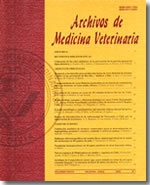Diurnal and nocturnal pulsatile growth hormone secretion in ewe lambs with and without food restriction
Main Article Content
Abstract
The aim of the study was to characterise and to compare diurnal (D) and nocturnal (N) GH secretion in normal growing and in food-restricted Suffolk ewe lambs. Pulsatile GH secretion was studied in 6, 20, 26 and 30 week-old lambs (group GC) and in six other lambs of the same age, after 5, 11 and 15 weeks of food restriction (group GR). At the end of the food restriction period, GR lambs were allowed food ad libitum for two weeks and the pulsatile GH secretion was studied again. The pulsatile GH secretion study consisted in the collection of blood samples from the jugular vein, at 10-min intervals, for 6 hours starting at 8:00 a.m. to characterize the diurnal GH secretion and at 8:00 p.m. to characterise the nocturnal GH secretion. The CLUSTER program was used to define GH pulse frequency (number of pulses/6h) and GH pulse amplitude (ng/mL). The mean plasma GH concentrations (ng/mL/6h) diminished from 10.8±1.1 (D) and from 12.9±0.7 ng/mL (N) in 20 week-old GC lambs to 6.3±1.0 (D) and 7.5±1.2 (N) in 30 week-old GC old lambs (P<0.05). In contrast, mean plasma GH concentrations increased from 15.9±1.4 (D) and 16.4±1.3 ng/mL (N) in 20 week-old GR lambs to 24.2±6.0 (D) and 25.1±3.0 ng/mL (N) in 30 week-old GR lambs (P<0.05). Mean plasma GH concentrations decreased rapidly in the GR lambs after 2 weeks of re-feeding, reaching values of 6.2±1.0 (D) and 6.2±0.5 ng/mL (N) (P<0.05 compared to GH values at 30 weeks of age). Diurnal and nocturnal mean plasma GH concentrations, GH pulse amplitude and GH pulse frequency were similar in each group and age studied. Mean plasma GH concentrations were always higher in GR than in GC lambs (P<0.05). Mean GH pulse amplitude was higher in 30 week-old GR lambs than in GC lambs. GH pulse frequency did not change with age in GC lambs nor with food restriction in GR lambs. It was similar between the groups. Results indicate that there is a steady decrease in GH secretion during pre-pubertal development which is not observed when lambs are placed under food restriction. Results also indicate that there is no daily rhythm in GH secretion either in normal growing lambs or in food restricted lambs.

